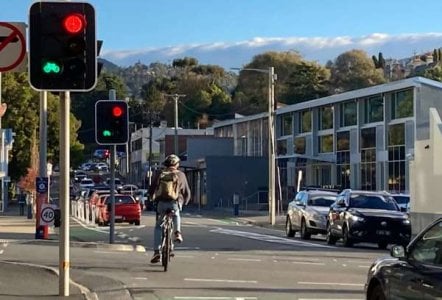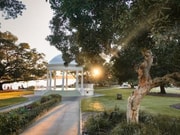Aussie city unveils road safety features in latest trial. Locals share opinions about the new system
By
Danielle F.
- Replies 5
The Australian traffic system has gone through several massive changes over the years.
With a series of new rules and trials implemented on the roads, it may be overwhelming to keep up with these new rules.
For those who have driven around Hobart lately, they may have noticed something different at the intersection of Collins, Harrington, and Barrack Streets.
Is it a stroke of genius for road safety, or just another headache for drivers?
The City of Hobart, in partnership with the Tasmanian Government, rolled out a two-year trial to transform Collins Street.
The project included new separated bike lanes for the 700-metre street, more roadside dining and extra parking.
However, the most contentious change was a special traffic light giving cyclists a few seconds head start before cars get the green light.
When the lights change, cyclists get to move first and clear the intersection before vehicles start rolling.
According to Neil Noye, the City of Hobart's Director of Strategic and Regulatory Services, this change could make the area safer for everyone.
'Collins Street has been identified and prioritised for pedestrian and cycling use,' Mr Noye explained.
He also added that the new lights were designed to 'provide greater safety for all road users by allowing cyclists to clear the intersection first before vehicles get their green light.'
For cyclists, this trial has been a long-overdue win.
Locals took to social media to share their excitement, calling the new lights 'amazing' and 'the start of better things to come in Tassie'.
Advocacy group Bicycle Network Tasmania stated that the head-start 'enables people riding and walking to get ahead of the traffic and be seen by turning vehicles'.
This change could be a crucial safety boost, especially in busy city centres.
Bicycle head-start lights have been used in Melbourne and other cities for over a decade, and Hobert is now following suit.
'There was a time when crashes were common,' a spokesperson for Bicycle Network explained.
'The light would turn green, the bikes would shoot off across the intersection, but a car would run left and strike the people on bikes going straight ahead.'
However, not all road users were thrilled with the change.
Some drivers complained about being stuck at red lights 'for the cyclists' lights without a bike in sight'.
One frustrated motorist called the change an 'overkill and another car delay system'.
It's a familiar refrain in the ongoing tug-of-war between cyclists and drivers on Aussie roads.
As with any new road feature, it takes time for everyone to get used to the change.
However, experts stated that just like with roundabouts and pedestrian crossings, these new systems should soon become second nature.
The changes on Collins Street were part of a bigger movement to make cities more bike-friendly.
Road safety authorities in other areas have also introduced 'bicycle boxes' so cyclists could wait in front of cars during red lights.
These measures also help reduce crashes by giving cyclists a head start and making them more visible to drivers.
According to a 2023 Tasmanian Government survey, cycling in Hobart has become popular, with 4,800 trips daily.
This result showed a 50 per cent jump compared to a similar survey done in 2019.
Officials also pointed out that more people riding bikes means fewer cars on the road, which could ease congestion on the roads.
Safety remains the number one concern for would-be cyclists, and separated bike lanes and head-start lights are designed to address that.
For cyclists, drivers, or pedestrians, changes like these are likely to become more common as cities want to improve safety, reduce congestion, and encourage greener transport.

Are these new traffic lights a smart move for safety or just another source of frustration for drivers? Have you seen similar features in your local area? We would love to read your thoughts and experiences in the comments below.
With a series of new rules and trials implemented on the roads, it may be overwhelming to keep up with these new rules.
For those who have driven around Hobart lately, they may have noticed something different at the intersection of Collins, Harrington, and Barrack Streets.
Is it a stroke of genius for road safety, or just another headache for drivers?
The City of Hobart, in partnership with the Tasmanian Government, rolled out a two-year trial to transform Collins Street.
The project included new separated bike lanes for the 700-metre street, more roadside dining and extra parking.
However, the most contentious change was a special traffic light giving cyclists a few seconds head start before cars get the green light.
When the lights change, cyclists get to move first and clear the intersection before vehicles start rolling.
According to Neil Noye, the City of Hobart's Director of Strategic and Regulatory Services, this change could make the area safer for everyone.
'Collins Street has been identified and prioritised for pedestrian and cycling use,' Mr Noye explained.
He also added that the new lights were designed to 'provide greater safety for all road users by allowing cyclists to clear the intersection first before vehicles get their green light.'
For cyclists, this trial has been a long-overdue win.
Locals took to social media to share their excitement, calling the new lights 'amazing' and 'the start of better things to come in Tassie'.
Advocacy group Bicycle Network Tasmania stated that the head-start 'enables people riding and walking to get ahead of the traffic and be seen by turning vehicles'.
This change could be a crucial safety boost, especially in busy city centres.
Bicycle head-start lights have been used in Melbourne and other cities for over a decade, and Hobert is now following suit.
'There was a time when crashes were common,' a spokesperson for Bicycle Network explained.
'The light would turn green, the bikes would shoot off across the intersection, but a car would run left and strike the people on bikes going straight ahead.'
However, not all road users were thrilled with the change.
Some drivers complained about being stuck at red lights 'for the cyclists' lights without a bike in sight'.
One frustrated motorist called the change an 'overkill and another car delay system'.
It's a familiar refrain in the ongoing tug-of-war between cyclists and drivers on Aussie roads.
As with any new road feature, it takes time for everyone to get used to the change.
However, experts stated that just like with roundabouts and pedestrian crossings, these new systems should soon become second nature.
The changes on Collins Street were part of a bigger movement to make cities more bike-friendly.
Road safety authorities in other areas have also introduced 'bicycle boxes' so cyclists could wait in front of cars during red lights.
These measures also help reduce crashes by giving cyclists a head start and making them more visible to drivers.
According to a 2023 Tasmanian Government survey, cycling in Hobart has become popular, with 4,800 trips daily.
This result showed a 50 per cent jump compared to a similar survey done in 2019.
Officials also pointed out that more people riding bikes means fewer cars on the road, which could ease congestion on the roads.
Safety remains the number one concern for would-be cyclists, and separated bike lanes and head-start lights are designed to address that.
For cyclists, drivers, or pedestrians, changes like these are likely to become more common as cities want to improve safety, reduce congestion, and encourage greener transport.
Key Takeaways
- Hobart introduced bicycle head-start lights at a busy intersection as part of a two-year trial to improve safety for cyclists.
- The new traffic lights could give cyclists a few seconds' head start before cars receive a green light.
- While many locals praised the initiative, some motorists have criticised the change, claiming it creates unnecessary delays.
- Cycling in Hobart has been on the rise, with daily trips up 50 per cent since 2019.








